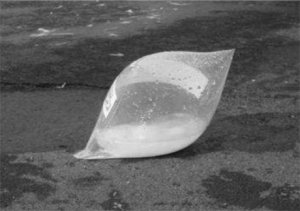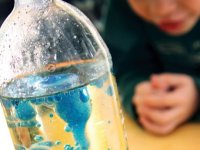3 Super-Simple Summer Science Activities
Summer is here -- a great time to get out, explore nature, and have a little family science fun. Here are my top three super-simple science demonstrations that mix the wow factor of any good science demo with some nice science exploration.
Blobs in a Bottle
Got one of those summer storms going through the neighborhood? It's a good time to share the wonders of the lava lamp with your kids while teaching them a thing or two about states of matter and intermolecular polarity . . . that's right, intermolecular polarity.
You will need:
- A clean, clear, 1-liter clear soda or water bottle
- 170 ml (3/4 cup) of water
- Vegetable oil (enough to almost fill up the bottle)
- Food coloring
- Fizzing tablets (such as Alka-Seltzer)
What to do:
- Pour the water into the bottle.
- Use a measuring cup or funnel to slowly pour the vegetable oil into the bottle until it's almost full. You may have to wait a few minutes for the oil and water to separate.
- Add 10 drops of food coloring to the bottle. Watch the drops pass through the oil untouched and then mix with the water below.
- Break a seltzer tablet in half, and drop the half tablet into the bottle. Watch it sink to the bottom and let the blobby greatness begin!
- To keep the effect going, just add another tablet piece. For a true lava lamp effect, turn off the lights, and shine a flashlight through the bottom of the bottle.
What’s going on?
Molecules of water and oil are built differently. Water is attracted to water, but it pushes away from oil because of invisible forces in its atoms. Because of that, water and oil do not mix. That's the intermolecular polarity part. The water is also denser, so it floats to the bottom of the bottle. Fizzing tablets do the job of carrying the water to the surface to make our lava lamp blobs. Far out!
The Exploding Lunch Bag
Here's a super-simple summer poolside activity featuring the two all-stars of childhood chemistry exploration: vinegar and baking soda.
You will need:
- One small sandwich-sized zip-lock bag (a freezer bag works best)
- Baking soda
- Vinegar
- A measuring cup
- A tissue
What to do:
- Go outside and enjoy the summer weather while experimenting . . . or at least do this in the kitchen sink.
- Pour 115 ml (1/2) cup of vinegar into the bag.
- Put 3 teaspoons of baking soda into the middle of the tissue.
- Wrap the baking soda up in the tissue by folding the tissue around it like a tiny baking soda burrito.
- Partially zip the bag closed, but leave enough space to add the baking soda packet. Put the tissue with the baking soda into the bag, but pinch it against the bag so it does not drop into the vinegar.
- Now zip the bag completely closed while holding the baking soda packet in place. When you're ready, let the baking soda drop and mix it with the vinegar.
- Put the bag in the sink or down on the ground (outside) and step back. You will see bubbly action, followed by bag inflation, followed by dramatic tension as it grows, followed by a pop, followed by giggles and probably a request to do it again.
No pop? Experiment again with more of each ingredient.
What’s going on?
Anyone can tell you that a gas takes up more space than a liquid or solid, but proving that fact by inflating a sandwich bag beyond its limits might do a better job of getting the idea across.

High-Flying Film Canister Rockets
Remember when film used to come in rolls? Back then, we discovered that you could turn a film canister into a really simple and impressive fizz-powered, Newton's-Law-demonstrating, high-flying rocket. It is still one of my favorite demonstrations, and perfect for a warm summer afternoon.
Film canisters? Where do I get film canisters? Many pharmacies and photo shops still develop film, and they're happy to give you used canisters. Also, film canisters are available online.
You will need:
- One empty 35mm plastic film canister and lid. The white canisters work much better than the black ones do.
- One fizzing antacid tablet (such as Alka-Seltzer tablets left over from Blobs in a Bottle, above)
- Water
- Safety goggles
What to do:
- Put on those safety goggles and head outside. When this works, that film canister really flies!
- Break the antacid tablet in half.
- Remove the lid from the film canister and put a teaspoon (5 ml) of water into the canister.
- Drop the tablet half into the canister and quickly snap on the cap (make sure that it snaps on tightly).
- Quickly put the canister on the ground cap side down and step back at least 2 meters.
- About 10 seconds later, you will hear a pop as the film canister launches into the air!
Safety note: If it does not launch, wait at least 30 second before examining the canister. Usually the cap is not on tightly enough and the buildup of gas has leaked out. Never stand or look over a canister that has not launched.
What’s going on?
What does it demonstrate? Newton’s third law ("A force is a push or a pull that acts upon an object as a results of its interaction with another object.") and that science is awesome! Happy summer exploring!
What science experiments do you try when the kids are home over summer break?
